
Hexen: Beyond Heretic is a fantasy first-person shooter video game developed by Raven Software and published by id Software through GT Interactive on October 30, 1995. It is the indirect sequel to 1994's Heretic, and the second game in Raven Software's "Serpent Riders" trilogy, which culminated with Hexen II. The title comes from the German noun Hexen, which means "witches", and/or the verb hexen, which means "to cast a spell". Game producer John Romero stated that a third, unreleased game in this series was to be called Hecatomb.
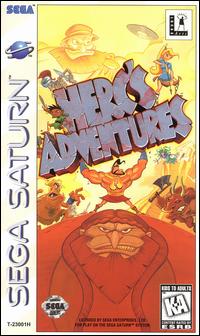
Herc's Adventures is a video game released for the PlayStation and the Sega Saturn by LucasArts in 1997. The overhead, action-adventure format is similar to Zombies Ate My Neighbors. Up to two players each take on the role of one of three ancient Greek heroes: Herc (Hercules), Atlanta (Atalanta), or Jason, who are on a quest to defeat Hades and save the goddess of nature, Persephone. In 2014, it was released for PSN in North America.
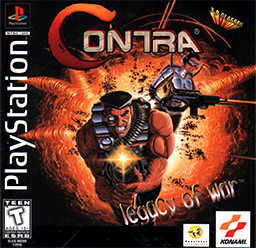
Contra: Legacy of War is a 3D action game produced by Konami and developed by Appaloosa Interactive that was originally released in 1996 for the PlayStation and Sega Saturn. It is a follow-up to Contra: Hard Corps, and was the first of two games in the Contra series that were externally developed by Appaloosa; the second game, C: The Contra Adventure, was released in 1998. Legacy of War marks the series' shift to three-dimensional graphics and gameplay, the game was released packaged with a pair of 3D anaglyph glasses, which enables the player to view the 3D effects incorporated into the game's graphics. Legacy of War bears the distinction for being the first console game in the series to retain both the Contra title and human characters during its release in Europe and Australia. The game was scheduled to be released in Japan as well, but was cancelled.
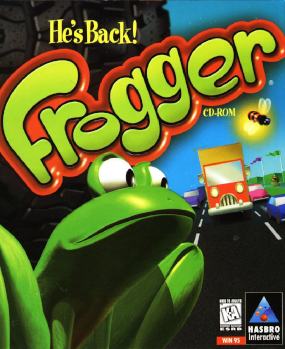
Frogger, also called Frogger: He's Back!, is an action video game remake and expansion of Konami's 1981 Frogger arcade game. It was developed by Sony Computer Entertainment's SCE Cambridge Studio and published by Hasbro Interactive in November 1997 for PlayStation and Windows. It has large maps, 3D graphics, and new gameplay moves. Critical reaction was mixed, with frequent criticism of the gameplay, controls, and difficulty, but the graphics were received positively. It was a commercial success, becoming one of the best-selling PlayStation games.
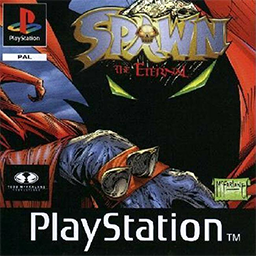
Spawn: The Eternal is an action-adventure video game developed by Sony Interactive Studios America and published by Sony Computer Entertainment for the PlayStation, based on the comic book character Spawn created by Todd McFarlane and produced by Image Comics. It was released on December 9, 1997 in North America and received poor reviews. When played on a CD player, the disc would be revealed to contain a lengthy audio interview with Spawn creator Todd McFarlane.
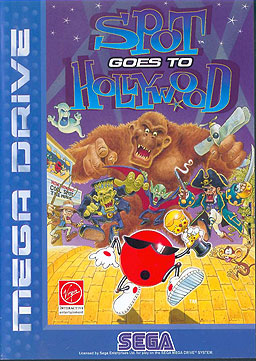
Spot Goes to Hollywood is a platform game developed by Eurocom and published by Acclaim Entertainment in North America and Virgin Interactive Entertainment in Europe for the Mega Drive/Genesis as the sequel to Cool Spot. Saturn and PlayStation versions were later released with full motion video clips and isometric graphics. The player controls Spot, once the mascot for the 7 Up soft drink, as it travels to various places trying to free its friends.

Spider: The Video Game, is a 2.5D platform game developed by Boss Game Studios and published by BMG Interactive for the PlayStation. The player takes the role of a cybernetic spider, within which the mind of its creator, Dr. Michael Kelly, has been implanted.

Madden NFL 97 is a football video game released in 1996. It was the first multiplatform Madden game released for the 32-bit consoles, being released on both the PlayStation and Sega Saturn. 16-bit versions were also made for the established Super NES and Genesis platforms, as well as a portable version for the Game Boy.

2Xtreme is a racing game released for the PlayStation in 1996 and a sequel to ESPN Extreme Games. Unlike the original, the game does not bear ESPN licensing. In it, the player races against others in various events around the world using Rollerblading, skateboarding, biking, and snowboarding. A sequel, 3Xtreme, was released in 1999.

Defcon 5 is an action-adventure video game developed by Millennium Interactive. It was released for MS-DOS in 1995, and ported to PlayStation, Sega Saturn and 3DO Interactive Multiplayer in 1996. The name refers to the condition used to designate normal peacetime military readiness under the DEFCON system, but which is commonly misused in popular fiction to indicate a state of emergency. The game was originally announced under the title Incoming.
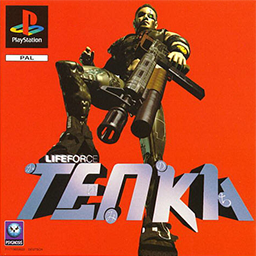
Lifeforce Tenka is a first-person shooter for PC and PlayStation released in 1997 by Psygnosis. It is also known as just "Tenka" in some other forms of release.

Lost Vikings 2 is a 1997 puzzle-platform game developed by Beam Software and published by Interplay. All versions of the game, except the SNES release, were titled Lost Vikings 2: Norse by Norsewest. The sequel to The Lost Vikings, it features the original three characters plus two new playable characters: Fang the werewolf and Scorch the dragon. The gameplay remains largely the same, though the three Viking characters all have new or modified abilities.

BattleSport is a 1996 futuristic sports video game developed by Cyclone Studios. It was originally published by Studio 3DO exclusively for their 3DO Interactive Multiplayer in 1996, but after the 3DO was discontinued BattleSport was published for other systems by Acclaim Entertainment. It was released for Windows and PlayStation in North America on June 30, 1997, and in Europe on August 1, 1997. It also saw a US only release on the Saturn.
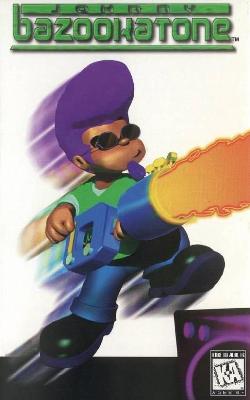
Johnny Bazookatone is a platforming video game developed by Arc Developments and published by U.S. Gold for the 3DO, PlayStation, Sega Saturn, and MS-DOS computers in 1996. Some releases also came equipped with a music CD based on the game's musical score. The game follows the protagonist, Johnny Bazookatone, trapped in the year 2050 in Sin Sin Prison by El Diablo, lord of the underworld. His guitar, known as "Anita" is taken from him, and so Johnny must travel to reclaim it.

Ballblazer Champions is an action/sports video game released for Sony's PlayStation console. It was developed by Factor 5 and published by LucasArts in North America, and by CTO SpA in Europe. It is a remake of the 1985 video game Ballblazer that was released for the Commodore 64 and Atari 8-bit family computers.

CrimeWave is a vehicular combat video game, developed and published by Eidos Interactive, released as a Sega Saturn exclusive in 1996-1997.

ReBoot is a 1998 video game developed and published by Electronic Arts for the PlayStation video game console. It is based on the television show of the same name. The story follows Bob stopping Megabyte's plan to take over Mainframe through the use of energy tears. The game's creation began in 1995, when two representatives met and agreed on the idea. EA Canada spent over the next three years going through various technological meetings during the development cycle. ReBoot garnered mixed reviews from critics who were divided over the digital control, gameplay and graphics.

Top Gun: Fire at Will is a video game developed and published by Spectrum HoloByte for DOS, Windows, PlayStation, and Mac OS. It is a licensed game in the Top Gun franchise. A sequel, Top Gun: Hornet's Nest, was released in 1998.
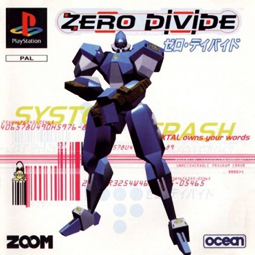
Zero Divide (ゼロ・ディバイド) is a 3D fighting video game developed by Zoom that was released for the PlayStation in 1995.

Auto Destruct is a video game developed by the Swedish studio Neurostone and published by Electronic Arts. It was released for the PlayStation. The player takes on the role of a retired race car driver hunting down the fanatical cult that murdered his wife and daughter. The music was composed by English electronic producer Danny Briottet.




















